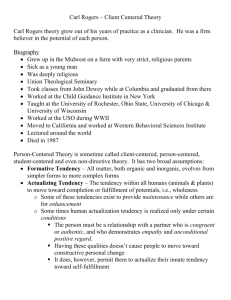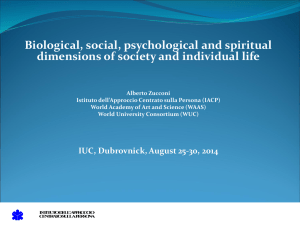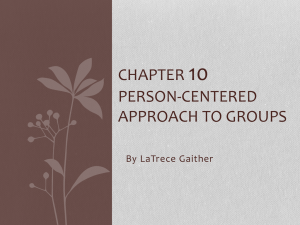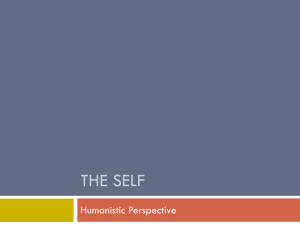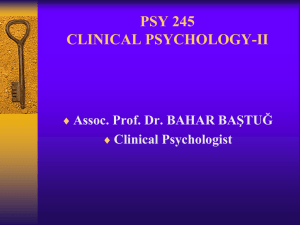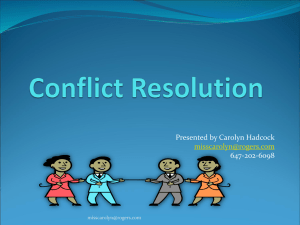Carl Rogers and Humanistic Psychology
advertisement
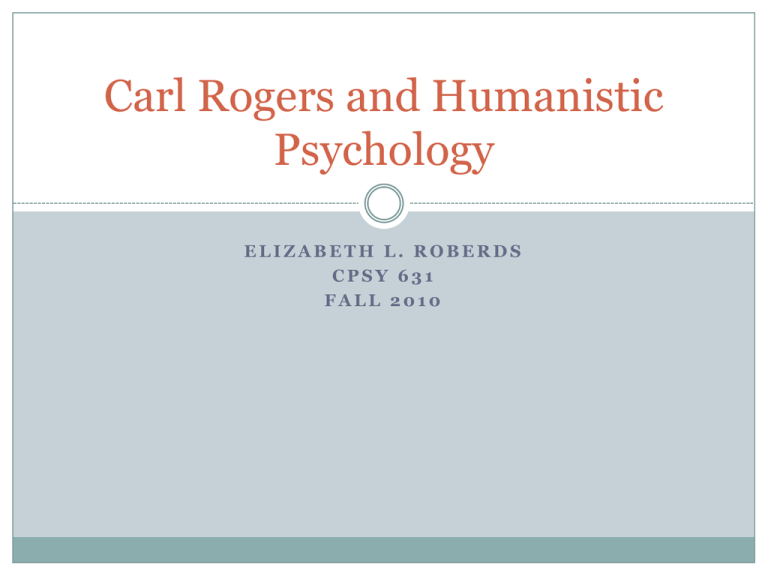
Carl Rogers and Humanistic Psychology ELIZABETH L. ROBERDS CPSY 631 FALL 2010 History and Background Born in 1902 in Chicago Background in psychology and education, Ph.D. from Columbia in 1931 Greatly influenced by Alfred Adler (Hergenhahn & Olson, 2003) Clinical experience in college counseling centers into the 1960s Development of person-centered philosophy President of APA in 1946 (Schultz & Schultz, 1994) Background • Rejected the unconscious as a dominant force beyond our control (Schultz & Schultz, 1994). • “Rejected the notion that past events exert a controlling influence on present behavior” and asserted that while “childhood experiences can affect the way we perceive ourselves and our environment,…that present feelings and emotions are of greater importance to the personality” (Schultz & Schultz, 1994, p. 301). Not very much like Freud (pictured here) Rogers on Personality “Rogers believed that personality can only be understood from the person’s own viewpoint, based on his or her subjective experiences. Thus, Rogers deals with reality as it is consciously perceived by each of us, and he noted that this perception may not always coincide with objective reality” (Schultz & Schultz, 1994, p. 302). The Self The self is a central construct in Rogers’ theory (Pescitelli, 1996). The self “develops through interactions with others and involves awareness of being and functioning,” and the concept of the self “is based largely on the social evaluations [a person] has experienced” (Pescitelli, 1996, p. 1). The self is “a major manifestation of the actualizing tendency, which…inclines the organism toward greater differentiation and complexity” (Hergenhahn & Olson, 2003, p. 471). A Positive View “An essentially optimistic view of human motivation and human nature” (Derlega et al., 2005, p. 138). Humans as innately good • “We can say that there is in every organism, at whatever level, an underlying flow of movement toward constructive fulfillment of its inherent possibilities. In human beings, too, there is a natural tendency toward a more complex and complete development. The term that has most often been used for this is the “actualizing tendency,” and it is present in all living organisms” (Rogers, 1980, pp. 117-118). The Actualizing Tendency The actualizing tendency is “a central, organizing or “master” motive [that] guides human behavior” (Derlega et al., 2005, p. 138). “The actualizing tendency is the natural human urge “to actualize, maintain, and enhance the experiencing organism”” (Rogers, 1951, p. 487 as cited in Hergenhahn & Olson, 2003, p. 468). Individuals thrive when this tendency is supported and suffer when this tendency is constrained (Derlega et al, 2005). Self-actualization is the goal Can the actualizing tendency be thwarted? “The actualizing tendency can, of course, be thwarted or warped, but it cannot be destroyed without destroying the organism” (Rogers, 1980, p. 118). This can happen when conflict exists “between a person’s inner experience and tendency toward actualization, and the need to be held in positive regard by others” (Derlega et al., 2005, p. 138). To avoid this experience, individuals must experience unconditional positive regard. Unconditional Positive Regard Unconditional positive regard allows the individual to avoid conflict between their actualizing tendency and their desire to be held in positive regard by others. Basis of healthy personality development (Derlega et al., 2005, p. 139). The Role of The Parent Ideally, unconditional positive regard would come from a child’s parents in the form of “unfailing expressions of acceptance, sympathy, warmth, and care for the child” (Derlega et al., 2005, p. 138). The child learns to trust their own feelings and experiences (Derlega et al., 2005, p. 138). Positive Self-Regard An internalized unconditional positive regard Results from the experience of unconditional positive regard from others Allows for a positive selfconcept and selftrust Conditions of Worth Unconditional positive regard is uncommon. “When significant others in the person's world (usually parents) provide positive regard that is conditional, rather than unconditional, the person introjects the desired values, making them his/her own, and acquires “conditions of worth”” (Rogers, 1959 as cited in Pescitelli, 2006, p. 1). Incongruity The need for positive regard fuels “a selective perception of experience in terms of the conditions of worth” that are perceived by the individual (Pescitelli, 1996, p. 1). The individual accurately perceives and experiences that are “in accordance” with the conditions of worth, and distorts or denies experiences that are not (Pescitelli, 1996, p. 1). “This leads to an incongruence between the self as perceived and the actual experience of the organism, resulting in possible confusion, tension, and maladaptive behavior” (Rogers, 1959 as cited in Pescitelli, 1996, p.1). The Fully Functioning Person Results from the experience of unconditional positive regard leading to positive self-regard. Such individuals trust their own judgment, easily correct mistakes, and are free from the constrains of “conditions of worth” (Derlega et al., 2005, p. 139). The Fully Functioning Person “Fully functioning” involves the following (Boeree, 2006): 1. Openness to experience: an accurate perception and acceptance of reality. Openness to feelings is necessary for actualization. May be difficult due to perceived conditions of worth. 2. Existential living: living in the present. 3. Organismic trusting: doing what feels natural, but assumes the actualizing tendency. 4. Experiential freedom: acknowledging feelings of freedom and taking responsibility for choices. 5. Creativity: participation in the world (similar to Erikson’s generativity). Not a “Pollyanna view of human nature” Rogers acknowledges that sometimes, despite the actualizing tendency, people do bad things. “I do not have a Pollyanna view of human nature. I am quite aware that out of defensiveness and inner fear individuals can and do behave in ways which are incredibly cruel, horribly destructive, immature, regressive, anti-social, and hurtful. Yet one of the most refreshing and invigorating parts of my experience is to work with such individuals and to discover the strongly positive directional tendencies which exist in them, as in all of us, at the deepest levels” (Rogers, 1961, p. 27 as cited in Hergenhahn & Olson, 2003, pp. 469-470). People Can Change Most people did not experience unconditional positive regard from their caregivers and are constrained by conditions of worth. Such people are functioning below that of a fully functioning person. Change is possible. Such individuals can still develop psychologically and remove the constrains of conditions of worth though a therapeutic experience with an appropriate environment (Pescitelli, 1996). “What if my parents didn’t provide me with unconditional positive regard?” The Person-Centered Approach to Therapy “Individuals have within themselves vast resources for self-understanding and for altering their self-concepts, basic attitudes, and self-directed behavior; these resources can be tapped if a definable climate of facilitative psychological attitudes can be provided” (Rogers, 1980, p. 115). The Person-Centered Approach to Therapy “There are three conditions that must be present in order for a climate to be growth-promoting. These conditions apply whether we are speaking of the relationship between therapist and client, parent and child, leader and group, teacher and student, or administrator and staff. These conditions apply, in fact, in any situation in which the development of the person is a goal” (Rogers, 1980, p. 115). The Three Conditions Genuineness, realness, or congruence “The term “transparent catches the flavor of this condition: the therapist makes himself or herself transparent to the client; the client can see right through what the therapist is in the relationship; the client experiences no holding back on the part of the therapist” (Rogers, 1980, p. 115). Acceptance or caring “What I have called “unconditional positive regard.” When the therapist is experiencing a positive, acceptant attitude toward whatever the client is at that moment, therapeutic movement or change is more likely to occur” (p. 116). Empathic understanding “The therapist senses accurately the feelings and personal meanings that the client is experiencing and communicates this understanding to the client” (p. 116). http://www.youtube.com/watch?v=ZBkUqcqRChg 6 min. (3:00-9:00) video clip of Rogers discussing the three conditions The Q-Sort Technique A technique found useful by Rogers (Hergenhahn & Olson, 2003). Client is given 100 cards with statements such as “I am intelligent” and “I despise myself” and are asked to sort the cards in piles representing “least like me” to “most like me.” The “most like me” piles represent the client's “real self.” Client is then asked to sort the cards again, but to sort them to describe how they want to be. This reflects the client’s “ideal self” (Hergenhahn & Olson, 2003). Class Activity Please break into groups of approx. 4 and discuss the following: Unconditional positive regard is not the norm within families. Most people experience conditional positive regard. What were some of the conditions of worth you perceived as having been or as being a part of your life experience? How has the effect of these conditions changed over time, if at all? (If you feel that you experienced unconditional positive regard, please share that experience). References Boeree, C. G. (2006). Carl Rogers. Retrieved September 20, 2009 from http://webspace.ship.edu/cgboer/rogers.html. Derlega, V., Winstead, B. A., & Jones, W. H. (2005). Personality (3rd ed.). Belmont, CA: Thomson Wadsworth. Hergenhahn, B. R. & Olson, M. H. (2003). An introduction to theories of personality (6th ed.). Upper Saddle River, NJ: Prentice Hall. Pescitelli, D. (1996). An analysis of Carl Rogers’ theory of personality. Retrieved September 20, 2009 from http://pandc.ca/?cat=carl_rogers&page=rogerian theory. Rogers, C. R. (1980). A Way of Being. Boston: Houghton Mifflin Company. Schultz, D. & Schultz, E. S. (1994). Theories of Personality (5th ed.). Pacific Grove, CA: Brooks/Cole Publishing Company.
